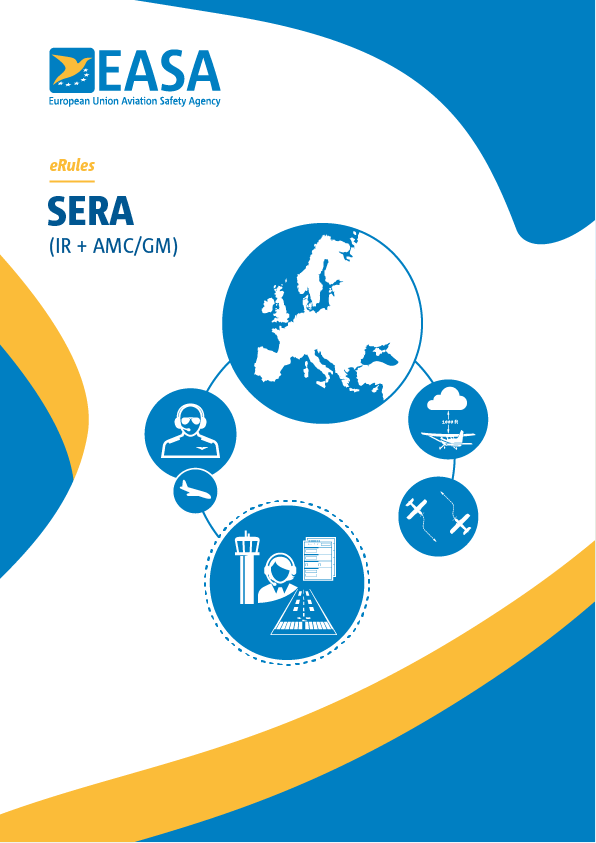SERA.7001 General — Objectives of the air traffic services
Regulation (EU) No 923/2012
The objectives of the air traffic services shall be to:
(a) prevent collisions between aircraft;
(b) prevent collisions between aircraft on the manoeuvring area and obstructions on that area;
(c) expedite and maintain an orderly flow of air traffic;
(d) provide advice and information useful for the safe and efficient conduct of flights;
(e) notify appropriate organisations regarding aircraft in need of search and rescue aid, and assist such organisations as required.
GM1 SERA.7001 General — Objectives of the air traffic services
ED Decision 2013/013/R
GENERAL
These provisions are general statements which represent high-level safety objectives to be met when providing ATS and which are the basis of all the provisions of this Part.
SERA.7002 Collision hazard information when ATS based on surveillance are provided
Regulation (EU) 2016/1185
(a) When an identified controlled flight is observed to be on a conflicting path with an unknown aircraft, deemed to constitute a collision hazard, the pilot of the controlled flight shall, whenever practicable:
(1) be informed of the unknown aircraft, and, if the pilot so requests, or if the situation so warrants in the opinion of the controller, avoiding action shall be suggested; and
(2) be notified when the conflict no longer exists.
AMC1 SERA.7002(a)(1) Collision hazard information when ATS based on surveillance are provided
ED Decision 2016/023/R
INFORMATION REGARDING TRAFFIC ON CONFLICTING PATH
(a) Information regarding traffic on a conflicting path should be given, whenever practicable, in the following form:
(1) relative bearing of the conflicting traffic in terms of the 12-hour clock;
(2) distance from the conflicting traffic in kilometres or nautical miles;
(3) direction in which the conflicting traffic appears to be proceeding; and
(4) level and type of aircraft or, if unknown, relative speed of the conflicting traffic, e.g. slow or fast.
(b) Pressure-altitude-derived level information, even when unverified, should be used in the provision of collision hazard information because such information, particularly if available from an otherwise unknown aircraft (e.g. a VFR flight) and given to the pilot of a known aircraft, could facilitate the location of a collision hazard. If the level information has not been verified, the accuracy of the information should be considered uncertain and the pilot should be informed accordingly.
GM1 to (a)(1) of AMC1 SERA.7002(a)(1) Collision hazard information when ATS based on surveillance are provided
ED Decision 2016/023/R
In cases where using the terms of the 12-hour clock is not practicable, like when the aircraft is turning, the direction of the unknown aircraft may be given by compass points, e.g. northwest, south, etc.;
GM1 to (a)(4) of AMC1 SERA.7002(a)(1) Collision hazard information when ATS based on surveillance are provided
ED Decision 2016/023/R
The level may be described either as a flight level, altitude or height, or as a relative vertical distance from the aircraft provided with traffic information (e.g. 1 000 ft above or 1 000 ft below).
GM1 SERA.7002(a)(1) Collision hazard information when ATS based on surveillance are provided
ED Decision 2020/007/R
INFORMATION REGARDING TRAFFIC ON CONFLICTING PATH OUTSIDE CONTROLLED AIRSPACE
When an identified IFR flight operating outside controlled airspace is observed to be on a conflicting path with another aircraft, the pilot should, as far as practicable:
(a) be informed as to the need for collision avoidance action to be initiated, and if so requested by the pilot or if, in the opinion of the air traffic controller, the FIS officer or the AFIS officer, the situation warrants, a course of avoiding action should be suggested; and
(b) be notified when the conflict no longer exists.
GM2 SERA.7002(a)(1) Collision hazard information when ATS based on surveillance are provided
ED Decision 2016/023/R
The information presented on a situation display may be used to provide identified aircraft with information regarding any aircraft observed to be on a conflicting path with the identified aircraft, and suggestions or advice regarding avoiding action.
GM3 SERA.7002(a)(1) Collision hazard information when ATS based on surveillance are provided
ED Decision 2016/023/R
The provision of collision hazard information does not absolve pilots of VFR flights from their responsibilities for avoiding terrain/obstacles and for maintaining visual meteorological conditions.
GM4 SERA.7002(a)(1) Collision hazard information when ATS based on surveillance are provided
ED Decision 2016/023/R
Collision hazard information should be provided where practicable. This should be done taking account of the priorities related to various tasks, such as provision of separation in accordance with the airspace classification, as well as equipment and workload limitations.
SERA.7005 Coordination between the aircraft operator and air traffic services
Regulation (EU) No 923/2012
(a) Air traffic services units, in carrying out their objectives, shall have due regard for the requirements of the aircraft operators consequent on their obligations as specified in the relevant Union legislation on Air Operations, and, if so required by the aircraft operators, shall make available to them or their designated representatives such information as may be available to enable them or their designated representatives to carry out their responsibilities.
(b) When so requested by an aircraft operator, messages (including position reports) received by air traffic services units and relating to the operation of the aircraft for which operational control service is provided by that aircraft operator shall, so far as practicable, be made available immediately to the aircraft operator or a designated representative in accordance with locally agreed procedures.
GM1 SERA.7005(a) Coordination between the aircraft operator and air traffic services
ED Decision 2013/013/R
GENERAL
The expression ‘due regard’ is meant to indicate that the air traffic services units, in their coordination with the aircraft operators, should take into account the obligations of the operators in accordance with the European Union rules on air operations, and provide them with the information they require to operate in accordance with those rules.
